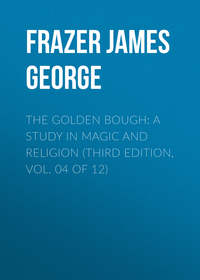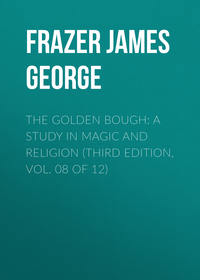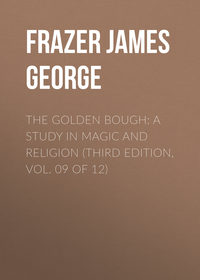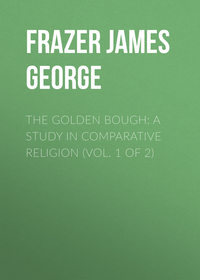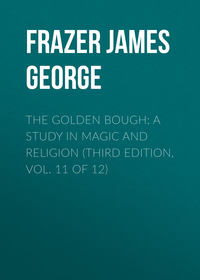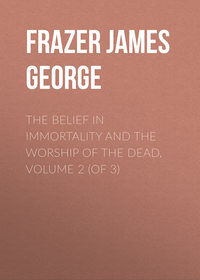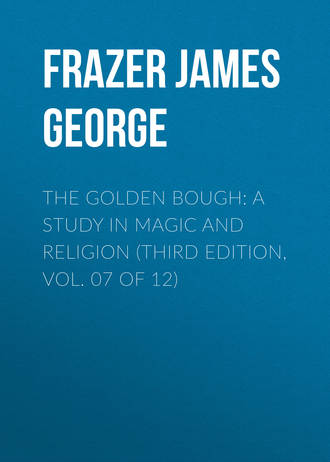 полная версия
полная версияThe Golden Bough: A Study in Magic and Religion (Third Edition, Vol. 07 of 12)
Quadriennial period of many of the great games of Greece. Old octennial period of the Pythian and probably of the Olympian games. The octennial cycle was instituted by the Greeks at a very early era for the purpose of harmonising solar and lunar time.
But in order to clear our ideas on this subject it is desirable to ascertain, if possible, the reason for holding the Eleusinian games at intervals of two or four years. The reason for holding a harvest festival and thanksgiving every year is obvious enough; but why hold games only every second or every fourth year? The reason for such limitations is by no means obvious on the face of them, especially if the growth of the crops is deemed dependent on the celebration. In order to find an answer to this question it may be well at the outset to confine our attention to the Great Eleusinian Games, which were celebrated only every fourth year. That these were the principal games appears not only from their name, but from the testimony of Aristotle, or at least of the author of The Constitution of Athens, who notices only the quadriennial or, as in accordance with Greek idiom he calls it, the penteteric celebration of the games.275 Now the custom of holding games at intervals of four years was very common in Greece; to take only a few conspicuous examples the Olympic games at Olympia, the Pythian games at Delphi, the Panathenaic games at Athens, and the Eleutherian games at Plataea276 were all celebrated at quadriennial or, as the Greeks called them, penteteric periods; and at a later time when Augustus instituted, or rather renewed on a more splendid scale, the games at Actium to commemorate his great victory, he followed a well-established Greek precedent by ordaining that they should be quadriennial.277 Still later the emperor Hadrian instituted quadriennial games at Mantinea in honour of his dead favourite Antinous.278 But in regard to the two greatest of all the Greek games, the Olympian and the Pythian, I have shewn reasons for thinking that they were originally celebrated at intervals of eight instead of four years; certainly this is attested for the Pythian games,279 and the mode of calculating the Olympiads by alternate periods of fifty and forty-nine lunar months,280 which added together make up eight solar years, seems to prove that the Olympic cycle of four years was really based on a cycle of eight years, from which it is natural to infer that in the beginning the Olympic, like the Pythian, games may have been octennial instead of quadriennial.281 Now we know from the testimony of the ancients themselves that the Greeks instituted the eight-years' cycle for the purpose of harmonising solar and lunar time.282 They regulated their calendar primarily by observation of the moon rather than of the sun; their months were lunar, and their ordinary year consisted of twelve lunar months. But the solar year of three hundred and sixty-five and a quarter days exceeds the lunar year of twelve lunar months or three hundred and fifty-four days by eleven and a quarter days, so that in eight solar years the excess amounts to ninety days or roughly three lunar months. Accordingly the Greeks equated eight solar years to eight lunar years of twelve months each by intercalating three lunar months of thirty days each in the octennial cycle; they intercalated one lunar month in the third year of the cycle, a second lunar month in the fifth year, and a third lunar month in the eighth year.283 In this way they, so to say, made the sun and moon keep time together by reckoning ninety-nine lunar months as equivalent to eight solar years; so that if, for example, the full moon coincided with the summer solstice in one year, it coincided with it again after the revolution of the eight years' cycle, but not before. The equation was indeed not quite exact, and in order to render it so the Greeks afterwards found themselves obliged, first, to intercalate three days every sixteen years, and, next, to omit one intercalary month in every period of one hundred and sixty years.284 But these corrections were doubtless refinements of a later age; they may have been due to the astronomer Eudoxus of Cnidus, or to Cleostratus of Tenedos, who were variously, but incorrectly, supposed to have instituted the octennial cycle.285 There are strong grounds for holding that in its simplest form the octennial cycle of ninety-nine lunar months dates from an extremely remote antiquity in Greece; that it was in fact, as a well-informed Greek writer tell us,286 the first systematic attempt to bring solar and the lunar time into harmony. Indeed, if the Olympiads were calculated, as they appear to have been, on the eight years' cycle, this of itself suffices to place the origin of the cycle not later than 776 b. c., the year with which the reckoning by Olympiads begins. And when we bear in mind the very remote period from which, judged by the wonderful remains of Mycenae, Tiryns, Cnossus and other cities, civilisation in Greek lands appears to date, it seems reasonable to suppose that the octennial cycle, based as it was on very simple observations, for which nothing but good eyes and almost no astronomical knowledge was necessary,287 may have been handed down among the inhabitants of these countries from ages that preceded by many centuries, possibly by thousands of years, the great period of Greek literature and art. The supposition is confirmed by the traces which the octennial cycle has left of itself in certain ancient Greek customs and superstitions, particularly by the evidence which points to the conclusion that at two of the oldest seats of monarchy in Greece, namely Cnossus and Sparta, the king's tenure of office was formerly limited to eight years.288
The motive for instituting the eight years' cycle was religious, not practical or scientific.
We are informed, and may readily believe, that the motive which led the Greeks to adopt the eight years' cycle was religious rather than practical or scientific: their aim was not so much to ensure the punctual despatch of business or to solve an abstract problem in astronomy, as to ascertain the exact days on which they ought to sacrifice to the gods. For the Greeks regularly employed lunar months in their reckonings,289 and accordingly if they had dated their religious festivals simply by the number of the month and the day of the month, the excess of eleven and a quarter days of the solar over the lunar year would have had the effect of causing the festivals gradually to revolve throughout the whole circle of the seasons, so that in time ceremonies which properly belonged to winter would come to be held in summer, and on the contrary ceremonies which were only appropriate to summer would come to be held in winter. To avoid this anomaly, and to ensure that festivals dated by lunar months should fall at fixed or nearly fixed points in the solar year, the Greeks adopted the octennial cycle by the simple expedient of intercalating three lunar months in every period of eight years. In doing so they acted, as one of their writers justly pointed out, on a principle precisely the reverse of that followed by the ancient Egyptians, who deliberately regulated their religious festivals by a purely lunar calendar for the purpose of allowing them gradually to revolve throughout the whole circle of the seasons.290
In early times the regulation of the calendar is largely an affair of religion.
Thus at an early stage of culture the regulation of the calendar is largely an affair of religion: it is a means of maintaining the established relations between gods and men on a satisfactory footing; and in public opinion the great evil of a disordered calendar is not so much that it disturbs and disarranges the ordinary course of business and the various transactions of civil life, as that it endangers the welfare or even the existence both of individuals and of the community by interrupting their normal intercourse with those divine powers on whose favour men believe themselves to be absolutely dependent. Hence in states which take this view of the deep religious import of the calendar its superintendence is naturally entrusted to priests rather than to astronomers, because the science of astronomy is regarded merely as ancillary to the deeper mysteries of theology. For example, at Rome the method of determining the months and regulating the festivals was a secret which the pontiffs for ages jealously guarded from the profane vulgar; and in consequence of their ignorance and incapacity the calendar fell into confusion and the festivals were celebrated out of their natural seasons, until the greatest of all the Roman pontiffs, Julius Caesar, remedied the confusion and placed the calendar of the civilised world on the firm foundation on which, with little change, it stands to this day.291
The quadriennial period of games and festivals in Greece was probably arrived at by bisecting an older octennial period.
On the whole, then, it appears probable that the octennial cycle, based on considerations of religion and on elementary observations of the two great luminaries, dated from a very remote period among the ancient Greeks; if they did not bring it with them when they migrated southwards from the oakwoods and beechwoods of Central Europe, they may well have taken it over from their civilised predecessors of different blood and different language whom they found leading a settled agricultural life on the lands about the Aegean Sea. Now we have seen reasons to hold that the two most famous of the great Greek games, the Pythian and the Olympian, were both based on the ancient cycle of eight years, and that the quadriennial period at which they were regularly celebrated in historical times was arrived at by a subdivision of the older octennial cycle. It is hardly rash, therefore, to conjecture that the quadriennial period in general, regarded as the normal period for the celebration of great games and festivals, was originally founded on elementary religious and astronomical considerations of the same kind, that is, on a somewhat crude attempt to harmonise the discrepancies of solar and lunar time and thereby to ensure the continued favour of the gods. It is, indeed, certain or probable that some of these quadriennial festivals were celebrated in honour of the dead;292 but there seems to be nothing in the beliefs or customs of the ancient Greeks concerning the dead which would suggest a quadriennial period as an appropriate one for propitiating the ghosts of the departed. At first sight it is different with the octennial period; for according to Pindar, the souls of the dead who had been purged of their guilt by an abode of eight years in the nether world were born again on earth in the ninth year as glorious kings, athletes, and sages.293 Now if this belief in the reincarnation of the dead after eight years were primitive, it might certainly furnish an excellent reason for honouring the ghosts of great men at their graves every eight years in order to facilitate their rebirth into the world. Yet the period of eight years thus rigidly applied to the life of disembodied spirits appears too arbitrary and conventional to be really primitive, and we may suspect that in this application it was nothing but an inference drawn from the old octennial cycle, which had been instituted for the purpose of reconciling solar and lunar time. If that was so, it will follow that the quadriennial period of funeral games was, like the similar period of other religious festivals, obtained through the bisection of the octennial cycle, and hence that it was ultimately derived from astronomical considerations rather than from any beliefs touching a quadriennial revolution in the state of the dead. Yet in historical times it may well have happened that these considerations were forgotten, and that games and festivals were instituted at quadriennial intervals, for example at Plataea294 in honour of the slain, at Actium to commemorate the great victory, and at Mantinea in honour of Antinous,295 without any conscious reference to the sun and moon, and merely because that period had from time immemorial been regarded as the proper and normal one for the celebration of certain solemn religious rites.
The reasons for bisecting the old octennial period into two quadriennial periods may have been partly religious, partly political.
If we enquire why the Greeks so often bisected the old octennial period into two quadriennial periods for purposes of religion, the answer can only be conjectural, for no positive information appears to be given us on the subject by ancient writers. Perhaps they thought that eight years was too long a time to elapse between the solemn services, and that it was desirable to propitiate the deities at shorter intervals. But it is possible that political as well as religious motives may have operated to produce the change. We have seen reason to think that at two of the oldest seats of monarchy in Greece, namely Cnossus and Sparta, kings formerly held office for periods of eight years only, after which their sovereignty either terminated or had to be formally renewed. Now with the gradual growth of that democratic sentiment, which ultimately dominated Greek political life, men would become more and more jealous of the kingly power and would seek to restrict it within narrower limits, and one of the most obvious means of doing so was to shorten the king's tenure of office. We know that this was done at Athens, where the dynasty of the Medontids was reduced from the rank of monarchs for life to that of magistrates holding office for ten years only.296 It is possible that elsewhere the king's reign was cut down from eight years to four years; and if I am right in my explanation of the origin of the Olympic games this political revolution actually took place at Olympia, where the victors in the chariot-race would seem at first to have personated the Sun-god and perhaps held office in the capacity of divine kings during the intervals between successive celebrations of the games.297 If at Olympia and elsewhere the games were of old primarily contests in which the king had personally to take part for the purpose of attesting his bodily vigour and therefore his capacity for office, the repetition of the test at intervals of four instead of eight years might be regarded as furnishing a better guarantee of the maintenance of the king's efficiency and thereby of the general welfare, which in primitive society is often supposed to be sympathetically bound up with the health and strength of the king.
The biennial period of some Greek games may have been obtained by bisecting the quadriennial period.
But while many of the great Greek games were celebrated at intervals of four years, others, such as the Nemean and the Isthmian, were celebrated at intervals of two years only; and just as the quadriennial period seems to have been arrived at through a bisection of the octennial period, so we may surmise that the biennial period was produced by a bisection of the quadriennial period. This was the view which the admirable modern chronologer L. Ideler took of the origin of the quadriennial and biennial festivals respectively,298 and it appears far more probable than the contrary opinion of the ancient chronologer Censorinus, that the quadriennial period was reached by doubling the biennial, and the octennial period by doubling the quadriennial.299 The theory of Censorinus was that the Greeks started with a biennial cycle of twelve and thirteen lunar months alternately in successive years for the purpose of harmonising solar and lunar time.300 But as the cycle so produced exceeds the true solar time by seven and a half days,301 the discrepancy which it leaves between the two great celestial clocks, the sun and moon, was too glaring to escape the observation even of simple farmers, who would soon have been painfully sensible that the times were out of joint, if they had attempted to regulate the various operations of the agricultural year by reference to so very inaccurate an almanac. It is unlikely, therefore, that the Greeks ever made much use of a biennial cycle of this sort.
Application of the foregoing conclusion to the Eleusinian games.
Now to apply these conclusions to the Eleusinian games, which furnished the starting-point for the preceding discussion. Whatever the origin and meaning of these games may have been, we may surmise that the quadriennial and biennial periods at which they were held were originally derived from astronomical considerations, and that they had nothing to do directly either with the agricultural cycle, which is annual, nor with the worship of the dead, which can scarcely be said to have any cycle at all, unless indeed it be an annual one. In other words, neither the needs of husbandry nor the superstitions relating to ghosts furnish any natural explanation of the quadriennial and biennial periods of the Eleusinian games, and to discover such an explanation we are obliged to fall back on astronomy or, to be more exact, on that blend of astronomy with religion which appears to be mainly responsible for such Greek festivals as exceed a year in their period. To admit this is not to decide the question whether the Eleusinian games were agricultural or funereal in character; but it is implicitly to acknowledge that the games were of later origin than the annual ceremonies, including the Great Mysteries, which were designed to propitiate the deities of the corn for the very simple and practical purpose of ensuring good crops within the year. For it cannot but be that men observed and laid their account with the annual changes of the seasons, especially as manifested by the growth and maturity of the crops, long before they attempted to reconcile the discrepancies of solar and lunar time by a series of observations extending over several years.
Varro on the rites of Eleusis.
On the whole, then, if, ignoring theories, we adhere to the evidence of the ancients themselves in regard to the rites of Eleusis, including under that general term the Great Mysteries, the games, the Festival before Ploughing (proerosia), the Festival of the Threshing-floor, the Green Festival, the Festival of the Cornstalks, and the offerings of first-fruits, we shall probably incline to agree with the most learned of ancient antiquaries, the Roman Varro, who, to quote Augustine's report of his opinion, “interpreted the whole of the Eleusinian mysteries as relating to the corn which Ceres (Demeter) had discovered, and to Proserpine (Persephone), whom Pluto had carried off from her. And Proserpine herself, he said, signifies the fecundity of the seeds, the failure of which at a certain time had caused the earth to mourn for barrenness, and therefore had given rise to the opinion that the daughter of Ceres, that is, fecundity itself, had been ravished by Pluto and detained in the nether world; and when the dearth had been publicly mourned and fecundity had returned once more, there was gladness at the return of Proserpine and solemn rites were instituted accordingly. After that he says,” continues Augustine, reporting Varro, “that many things were taught in her mysteries which had no reference but to the discovery of the corn.”302
The close resemblance between the artistic types of Demeter and Persephone militates against the theory that the two goddesses personified two things so different as the earth and the corn.
Thus far I have for the most part assumed an identity of nature between Demeter and Persephone, the divine mother and daughter personifying the corn in its double aspect of the seed-corn of last year and the ripe ears of this, and I pointed out that this view of the substantial unity of mother and daughter is borne out by their portraits in Greek art, which are often so alike as to be indistinguishable. Such a close resemblance between the artistic types of Demeter and Persephone militates decidedly against the view that the two goddesses are mythical embodiments of two things so different and so easily distinguishable from each other as the earth and the vegetation which springs from it. Had Greek artists accepted that view of Demeter and Persephone, they could surely have devised types of them which would have brought out the deep distinction between the goddesses. That they were capable of doing so is proved by the simple fact that they regularly represented the Earth Goddess by a type which differed widely both from that of Demeter and from that of Persephone.303 Not only so, but they sometimes set the two types of the Earth Goddess and the Corn Goddess (Demeter) side by side as if on purpose to demonstrate their difference. Thus at Patrae there was a sanctuary of Demeter, in which she and Persephone were portrayed standing, while Earth was represented by a seated image;304 and on a vase-painting the Earth Goddess is seen appropriately emerging from the ground with a horn of plenty and an infant in her uplifted arms, while Demeter and Persephone, scarcely distinguishable from each other, stand at full height behind her, looking down at her half-buried figure, and Triptolemus in his wheeled car sits directly above her.305 In this instructive picture, accordingly, we see grouped together the principal personages in the myth of the corn: the Earth Goddess, the two Goddesses of the old and the new corn, and the hero who is said to have been sent forth by the Corn Goddess to sow the seed broadcast over the earth. Such representations seem to prove that the artists clearly distinguished Demeter from the Earth Goddess.306 And if Demeter did not personify the earth, can there be any reasonable doubt that, like her daughter, she personified the corn which was so commonly called by her name from the time of Homer downwards? The essential identity of mother and daughter is suggested, not only by the close resemblance of their artistic types, but also by the official title of “the Two Goddesses” which was regularly applied to them in the great sanctuary at Eleusis without any specification of their individual attributes and titles,307 as if their separate individualities had almost merged in a single divine substance.308
As goddesses of the corn Demeter and Persephone came to be associated with the ideas of death and resurrection.
Surveying the evidence as a whole, we may say that from the myth of Demeter and Persephone, from their ritual, from their representations in art, from the titles which they bore, from the offerings of first-fruits which were presented to them, and from the names applied to the cereals, we are fairly entitled to conclude that in the mind of the ordinary Greek the two goddesses were essentially personifications of the corn, and that in this germ the whole efflorescence of their religion finds implicitly its explanation. But to maintain this is not to deny that in the long course of religious evolution high moral and spiritual conceptions were grafted on this simple original stock and blossomed out into fairer flowers than the bloom of the barley and the wheat. Above all, the thought of the seed buried in the earth in order to spring up to new and higher life readily suggested a comparison with human destiny, and strengthened the hope that for man too the grave may be but the beginning of a better and happier existence in some brighter world unknown. This simple and natural reflection seems perfectly sufficient to explain the association of the Corn Goddess at Eleusis with the mystery of death and the hope of a blissful immortality. For that the ancients regarded initiation in the Eleusinian mysteries as a key to unlock the gates of Paradise appears to be proved by the allusions which well-informed writers among them drop to the happiness in store for the initiated hereafter.309 No doubt it is easy for us to discern the flimsiness of the logical foundation on which such high hopes were built.310 But drowning men clutch at straws, and we need not wonder that the Greeks, like ourselves, with death before them and a great love of life in their hearts, should not have stopped to weigh with too nice a hand the arguments that told for and against the prospect of human immortality. The reasoning that satisfied Saint Paul311 and has brought comfort to untold thousands of sorrowing Christians, standing by the deathbed or the open grave of their loved ones, was good enough to pass muster with ancient pagans, when they too bowed their heads under the burden of grief, and, with the taper of life burning low in the socket, looked forward into the darkness of the unknown. Therefore we do no indignity to the myth of Demeter and Persephone – one of the few myths in which the sunshine and clarity of the Greek genius are crossed by the shadow and mystery of death – when we trace its origin to some of the most familiar, yet eternally affecting aspects of nature, to the melancholy gloom and decay of autumn and to the freshness, the brightness, and the verdure of spring.


